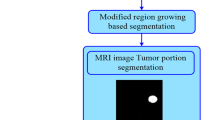Abstract
The Brain is the one that has a significant impact on the control and managing of the entire body. The ability to see, hear, think, walk, talk, feel, remember, and a lot more, and also the breathing which is the essential part to stay alive is controlled by the Brain. So it is a crucial part to take care of the brain from various diseases. Tumors, which are collections of abnormal growth of cells, can cause damage to the brain and can be malignant or non-cancerous. Here we are focusing on meningiomas, the majority of meningiomas are benign (non-cancerous) and slow-growing, although some are malignant. The detection of these types of tumors can be a daring task. As technology evolved, there are various methods that can detect brain tumors and even classify their types. The proposed work follows a hybrid feature extraction method that fuses PCA and GIST and also uses the SeaLion algorithm for optimization purposes. With the hybrid feature extraction techniques and the SLnO, the designed method shows a better classification accuracy. The paper includes the workflow of the proposed strategy, the first phase is all about the preprocessing of the image using the CLAHE and the anisotropic diffusion followed by the segmentation in the second phase, uses K-means, then the feature extraction in the third phase. The fourth phase deals with the optimization and finally the classification of inputs. The trials were conducted on 100 images from the human brain and a synthetic MRI dataset, with 25 images being healthy and 75 being problematic. On both training and test imagery, the classification performance was found to be 98.56%.
Access this chapter
Tax calculation will be finalised at checkout
Purchases are for personal use only
Similar content being viewed by others
References
Hashemzehi, R., Mahdavi, S., Kheirabadi, M., Kamel Tabbakh, S.: Detection of brain tumors from MRI images base on deep learning using hybrid model CNN and NADE. Biocybern. Biomed. Eng. 40 (2020). https://doi.org/10.1016/j.bbe.2020.06.001
Sasank, V.V.S., Venkateswarlu, S.: Brain tumor classification using modified kernel based softplus extreme learning machine. Multimed. Tools Appl. 80(9), 13513–13534 (2021). https://doi.org/10.1007/s11042-020-10423-5
Mohsen, H., El-Dahshan, E.-S., El-Horbarty, E.-S., Salem, M.A.-B.: Classification using deep learning neural networks for brain tumors. Future Comput. Inform. J. 3. https://doi.org/10.1016/j.fcij.2017.12.001
Khan, S., Hussain, S., Yang, S.: Contrast enhancement of low-contrast medical images using modified contrast limited adaptive histogram equalization. J. Med. Imaging Health Infor. 10, 1795–1803 (2020). https://doi.org/10.1166/jmihi.2020.3196
Reza, A.M.: Realization of the contrast limited adaptive histogram equalization (CLAHE) for real time image enhancement. J VLSI Signal Process System 38(1), 35–44 (2004)
Perona, P., Malik, J.: Scale-space and edge detection using anisotropic diffusion. IEEE Trans. Pattern Anal. Mach. Intell. 12(7), 629–639 (1990). https://doi.org/10.1109/34.56205
Gumaei, A., Hassan, M.M., Hassan, M.R., Alelaiwi, A., Fortino, G.: A hybrid feature extraction method with regularized extreme learning machine for brain tumor classification. IEEE Access 7, 36266–36273 (2019). https://doi.org/10.1109/ACCESS.2019.2904145
Latha, H.R., Rama Prasath, A.: Enhanced image security using new sea lion optimization algorithm. International Journal of Innovative Technology and Exploring Engineering (IJITEE), ISSN: 2278–3075, 9(7) (May 2020)
Masadeh, R., Mahafzah, B.A., Sharieh, A.: Sea lion optimization algorithm. (IJACSA) International Journal of Advanced Computer Science and Applications, 10(5) (2019)
Suryani, D., Doetsch, P., Ney, H.: On the benefits of convolutional neural network combinations in offline handwriting recognition. In: Proceedings of 15th International Conference on Frontiers in Handwriting Recognition (ICFHR), pp. 193–198. Shenzhen, China, October 2016
Albawi, S., Mohammed, T., Al-azawi, S.: Understanding of a convolutional neural network. In: Proceedings of 2017 International Conference on Engineering & Technology (ICET’2017), pp. 274–279. Akdeniz University, Antalya, Turkey, August 2017
Aswathy, S.U., Devadhas, G., Kumar, S.S.: Quick detection of brain tumor using a combination of EM and level set method. Indian J. Sci. Technol. 8(34) (2015)
Aswathy, S.U., Devadhas, G., Kumar, S.S.: A survey on detection of brain tumor from MRI brain images. In: 2014 International Conference on Control, Instrumentation, Communication and Computational Technologies (ICCICCT), pp. 871–877 (2014)
Aswathy, S.U., Devadhas, G.G., Kumar, S.S.: An improved tumor segmentation algorithm from T2 and FLAIR multimodality MRI brain images by support vector machine and genetic algorithm. Cogent Eng. 5(1), 1470915 (2019)
Author information
Authors and Affiliations
Editor information
Editors and Affiliations
Rights and permissions
Copyright information
© 2022 The Author(s), under exclusive license to Springer Nature Switzerland AG
About this paper
Cite this paper
Aswathy, S.U., Stephen, D., Vincent, B., Prajoon, P. (2022). A Hybrid Feature Extraction Method Using SeaLion Optimization for Meningioma Detection from MRI Brain Image. In: Abraham, A., et al. Innovations in Bio-Inspired Computing and Applications. IBICA 2021. Lecture Notes in Networks and Systems, vol 419. Springer, Cham. https://doi.org/10.1007/978-3-030-96299-9_4
Download citation
DOI: https://doi.org/10.1007/978-3-030-96299-9_4
Published:
Publisher Name: Springer, Cham
Print ISBN: 978-3-030-96298-2
Online ISBN: 978-3-030-96299-9
eBook Packages: Intelligent Technologies and RoboticsIntelligent Technologies and Robotics (R0)




